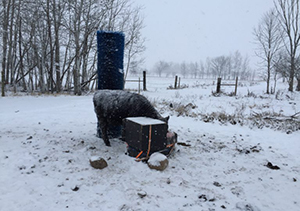December Farm Update
2016 is almost over! Where did the time go? We are now past the midway point of December and winter has definitely begun. Last Sunday we had a low of 27 degrees below zero on our farm. Although we did not want such cold temps, it did give us the opportunity to see how well our modified winter waterer would hold up in the frigid temperatures.
If you read my blogs last winter, you will recall that we had problems keeping our Non-electric Ritchie Winter Waterer from freezing up anytime the temps dropped below -5 degrees. The Ritchie Non-electric Waterer does work well. It is just that there really aren’t any non-electric winter waterers that can perform at those temps.
After much research, brainstorming, and planning of solutions (that for one reason or another just were not feasible), we settled on a plan we thought would work. We decided to change a couple of different things. The first was to get a new water valve and float assembly. Our old valve was above the water level and the nozzle had a tendency to be the first spot to freeze up. We removed that assembly and installed a new valve assembly. The new one has the valve under the water level. By placing the valve under the water level, the nozzle would now be one of the last places on the waterer to freeze up.
The second change we wanted to make was to add a submersible heating element to the waterer for times when the temps really dropped. We ended up getting a low watt submersible heating element that could run on a 12 volt marine battery. Through testing, we found we could get about 1 1/2 to 2 days life out of a battery. This was easy enough, until we tried to figure out how to attach the heating element inside the waterer. The elements are made to be threaded into the drain plug threads on the tank. The problem was that Ritchie waterers have a rubber drain plug instead of a threaded drain plug. We purchased a coupling that had the threads we needed and would slide into the drain opening. The next problem was finding a glue that would work on rotomolded plastic. This turned out to be the hardest part of the project. After a few trials and errors, we did find a very expensive epoxy that did the job.

After watching the weather forecast, we knew that all our planning and fixing would be put to the test. After finishing farm chores on Saturday the 17th, we were leaving to go up north for a family Christmas gathering and wouldn’t be back until Sunday afternoon. It was not ideal to be gone over such a cold snap, but that is the way it worked out. Saturday morning, I went out and installed the battery and started the heating element. Then we left for up north. Sunday, as soon as we returned, I anxiously hurried out to check the waterer. With temps still hovering around 20 below I wasn’t sure what to expect. As I walked up to the waterer, I could see by the tracks in the snow that the cattle had been there already. When I looked at the waterer, I was relieved to see that it was completely ice free and functioning perfectly. It was nice to know that all our time and work with this had paid off.
Because we had such a long warm fall, we still have stockpiled pasture available for our finishing cattle. In fact, we have enough pasture stockpiled to last us into the new year. This has allowed us to schedule butchering dates much later this year. We will have one more butchering date in January. If you are interested in getting meat yet this winter, let us know.

